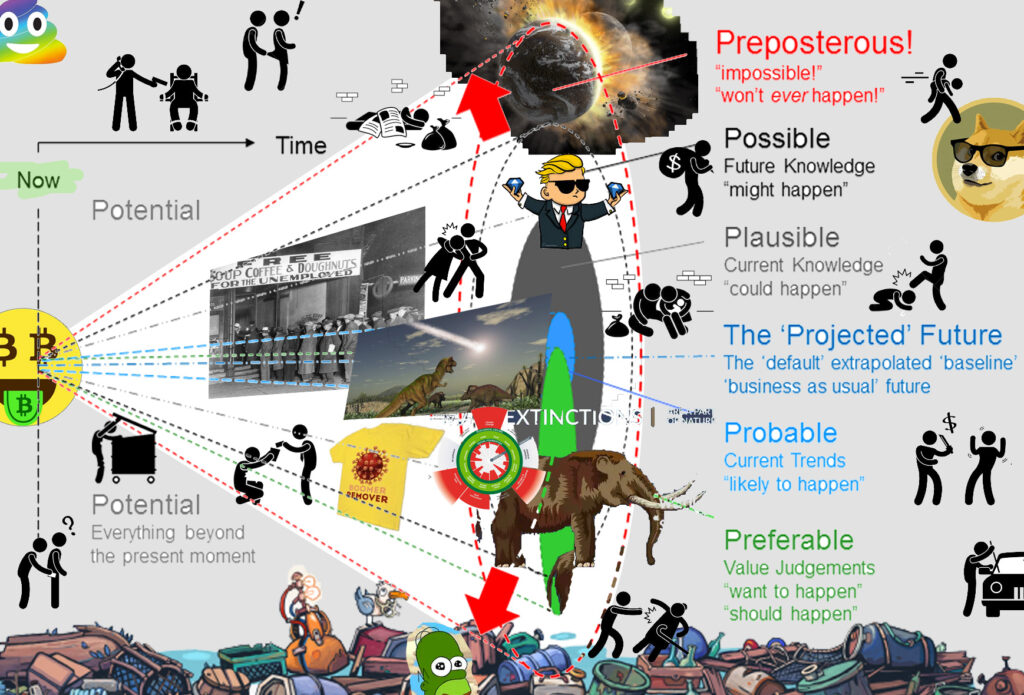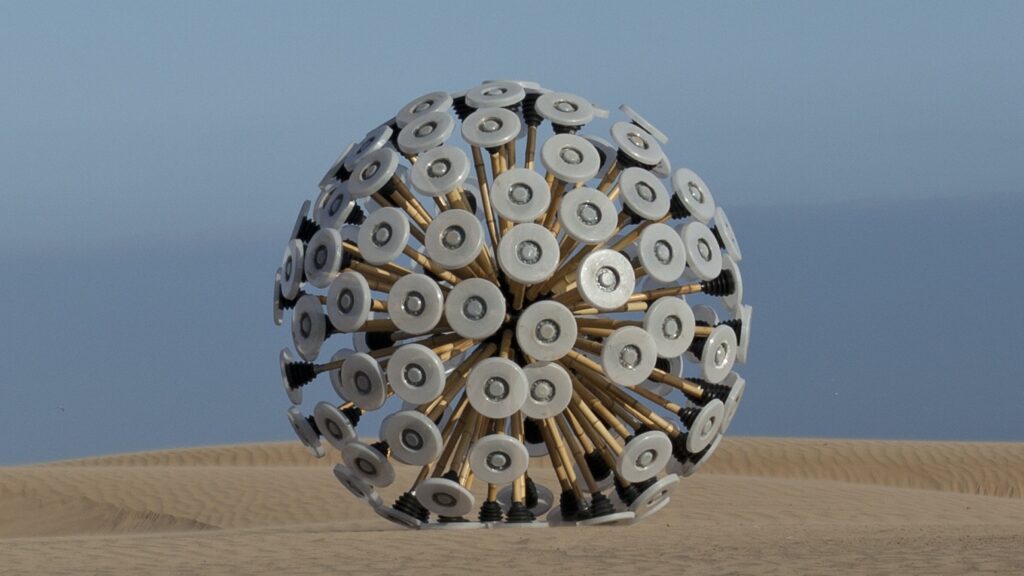Time to start thinking about the world you don’t want.
Exhibition essay for A World We Don’t Want
Pre-print draft of an essay I wrote for the exhibition A World We Don’t Want curated by Friends & Associates for Melbourne Design Week 2021, supported by the National Gallery of Victoria. The original version has since been taken down but was here.
My girlfriend has an unusual worldview. It’s a kind of philosophy or theory of reality. She believes that anything you think of can never come true. She knows you can imagine winning a prize and still win that prize but thinks that if she imagines exactly how she might win that prize –the mark on a judge’s scorecard or how her lottery number is pulled from a barrel– then that specific reality can no longer come true. She whittles down the realm of the possible by cancelling out other futures. She prefers not to imagine good things happening, to maximise the chance they do.
Preferring to imagine the worst of outcomes, rather than the best, isn’t especially healthy. But we’ve talked about that and over time she’s softened her take on it. In fact, as she becomes more successful in her career, she’s flipped the script somewhat and started doing the opposite, something well known as the ‘power of positive thinking’ or ‘positive visualisation’. Anyone remember The Secret? These things make me laugh because as much as I use visualisation techniques myself, I’m aware of how close they dabble near the dark arts of solipsism, the untestable idea that reality exists entirely in one’s own mind.
But design does actually work a bit like this. Materialising concepts into form gives shapes to beliefs and ideas. Even though this can be risky. I find it incredible how non-designers can be so convinced by concept designs and speculative prototypes. One example: in 2014 a Sydney designer proposed a smart helmet for bicyclists that included a license plate, ‘windscreen’ wipers and brake lights, among other features so irrational (because they are adapted from safety and congestion issues not applicable to cyclists) that I can barely expend the energy to type them out. But the concept images fuelled the debate on licensing cyclists –nearly a reality in New South Wales– and arguably gave rise to a whole suite of similar, supposedly better designed, but equally irrational, ‘smart’ cycling helmets promoted and sold by major manufacturers today.

Designed objects offer the promise of a solution by way of just being ‘made’. Speculation in form both creates and uncreates the world. They make the world we want and the world we don’t want. Contemporary theories of speculative design and ‘design fiction’ use the diagram of the Futures Cone to illustrate this power of making and unmaking. It is proposed to be akin to a torch beam: speculative design in the now has potential to shift the torch’s light away from the abject, probable futures, to better see preferable futures.

I think, like my girlfriend’s brain, some kooky speculations shine a light that stops further exploration in certain directions. This is somewhat like the null hypothesis in science, in which science usefully discovers a dead end for other scientists to avoid. The field of design might do well to have more null hypotheses too. There is, however, a publication bias problem in science. Null hypotheses are not being published to the degree they should for fear they damage their author’s reputation. In the fuzzier world of design, as the example of the smart helmet indicates, null hypotheses might not have this issue because there is a lack of critical evaluation identifying them as null hypotheses in the first place. The marketing machine of design blinds many, as was the case when Massoud Hassani designed the Mine Kafon in 2011 on the premise it would safely clear landmines. Spoiler: it doesn’t, though that didn’t stop MOMA and the design festival PR machine touting its potential for years. But, because the studio or lab failures of mainstream design companies are rarely published we should be thankful for brave designers that propose unexpected or unusual designs of speculative imagination in exhibition contexts, even if they may sometimes be naive.

As a designer, I feel that giving concepts a shape is like a child blowing bubbles. They are mostly ephemeral, but the sheer joy of materialising ideas into form makes their fleetingness beside the point, momentarily. They pop and disappear, for the most part, though some bubbles, sticky with starch, land on hands or grass and persist, for a time, marvellous and prescient, shiny glimpses of a possible future we can choose.
Choosing your future (rather than shaping your future) from an array of bubbly options is a staple of science fiction. Commonly it is presented in the theory of infinite parallel worlds that continually fork from ours. To choose an optimum future, we just need to jump across or slide into the right timeline. The idea is a scientifically plausible, but untestable, solution to experimental contradictions in the quantum physics that govern our sub-atomic world.
An unusual concept arising from the theory of these parallel quantum worlds is quantum immortality, the concept that because so many worlds exist, splitting off from each other at every moment, action and reaction, there will always be a world in which consciousness –your consciousness– survives. Every time you pick up a gun to play Russian roulette, you’ll slide into the universe in which the bullet spins to the bottom of the barrel. With your fully loaded gun, having assured yourself you’ll end it all forever, the gun continually jams. This is relative: your friends and family in adjacent timelines see your body slump to the floor, but for you, the truck swerves, your stomach is pumped, and the doctors resuscitate you time and time again, keeping you alive well into your hundreds. Growing older still, your consciousness finds itself escaping again and again into more and more slim probabilities of survival in increasingly weird realities until –as happens in the classic short story Divided by Infinity by Robert Charles Wilson– you find your body eaten by robotic teeth 10,000 years in the future so your consciousness can live on inside the body of an alien centipede.
(By the way, Professor Hugh Everett the third, the first scientist to propose the many worlds theory of quantum physics, personally believed in quantum immortality. He smoked and drank himself to an early death at 51 years of age.)
So, the theorists contend, if quantum immortality exists, we should make wise decisions to maintain as many parallels forks as possible, so our many lives can live on in pleasant or, at least, less than extreme scenarios. The concept is reflected in contemporary design theory; Tony Fry (2009) proposes much design is defuturing, “the negation of world futures”, design that closes down future opportunities. Similar ideas go back deep in philosophy, for example, to Spinoza, the 17th century atheist lens-grinder, who was remarkably able to theorise a metaphysics absent of god yet avoid the recriminations of the church. His view of nature establishes an ethic: decisions are not good or bad in of themselves, but in how they open or close down the potential to act in the future. He terms this affective power. Taking care of soil is good because it enables crops to be grown, even if you decide to build on it instead. Polluting the soil with toxins is bad because you can’t grow crops or build a safe building. Pollution closes down the opportunities of non-humans –bugs, microbes, plants and animals– to also live through the sustenance of the soil. This seems obvious, but we make these mistakes again and again. Spinoza proposes a way we can ethically critique design in terms of future consequence, hopefully distinguished from social norms or cultural bias. Or, as Fry says: “The entire enterprise of bringing oneself into a confrontation with defuturing, and thereafter acting on this knowledge, rests on judgement.”
Fry, T. (2009). Design futuring: Sustainability, ethics, and new practice.